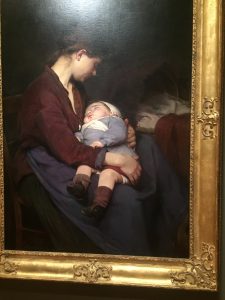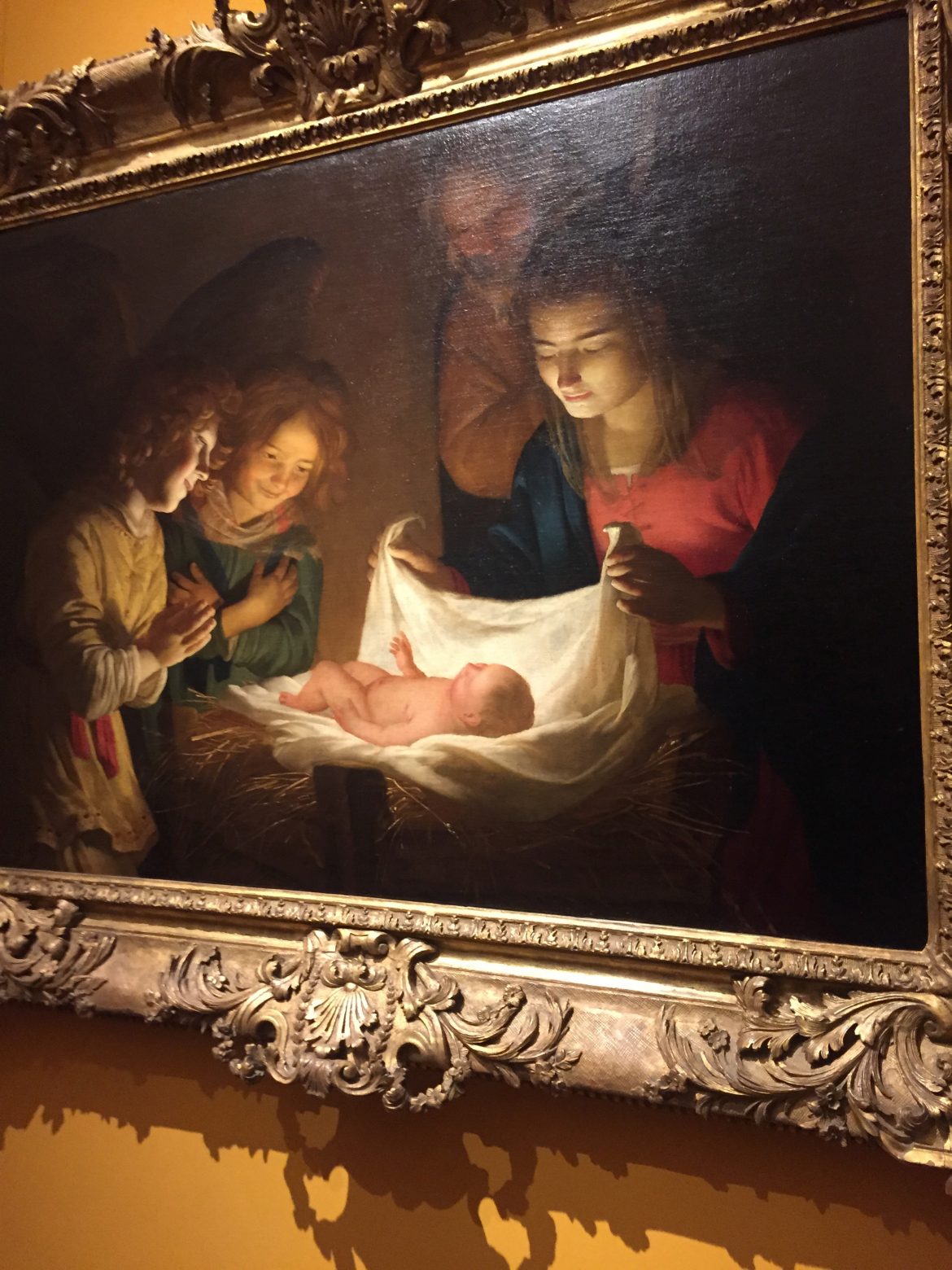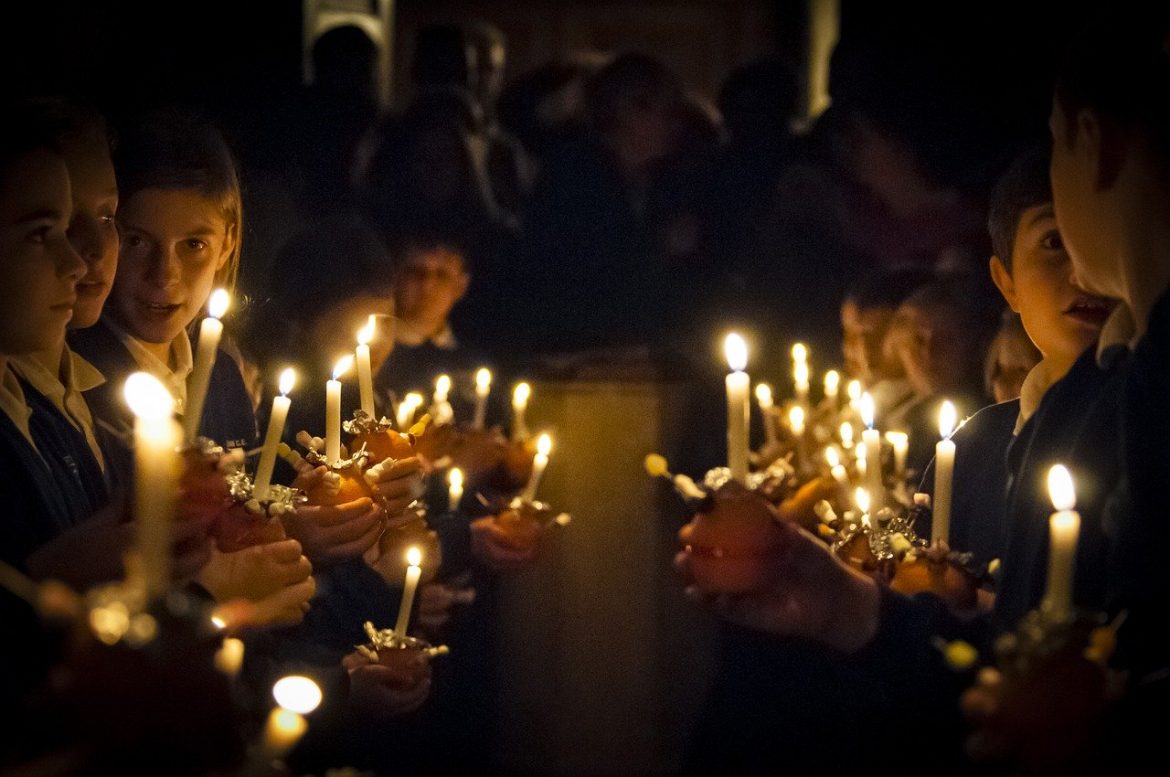By Ellen Haroutunian —
Most people are aware that the winter solstice (for the Northern Hemisphere) marks the shortest day of the year as the North Pole tilts the farthest away it will be from the sun. The word solstice means “sun standing,” named as such because for a few days the sun appears to rise and set from the very same place. There seems to be a pause, a time of waiting in the dark. Then slowly the sun begins her journey back towards the south. The days lengthen and the light and warmth return. From the beginning of civilization there have been rituals of merriment to celebrate that we have survived the long, cold darkness. The sun is joyfully welcomed back.
Solstice celebrations have grown in popularity today even for many people who may not have ethnic or religious roots in the tradition. It’s a lovely way to recognize the wonder and beauty of the planet we live on and marvel at the dance of the earth around the sun. To be fair, some of us are just glad to know we will not to have to go to work and come home again in the dark much longer.
There’s another reason to be glad for solstice celebrations. They reflect something from our ancient past that we have lost in our sophisticated, scientific age. Pre-modern people who celebrated solstice (and other natural phenomena) lived immersed in a sense of an enchanted world. They were aware of something larger than themselves, something that infused all of the earth—its abundant fertility, its powerful forces that both terrified and awed, and its creatures that nourished, warmed and fascinated. Everything pulsated with life. No wonder there were so many stories of faeries and sprites and goblins. What else could explain so much magic? Not the gods alone.
Early Greek philosophers created their own framework of understanding of this magical realm. Plato, for example, believed that physical reality in which we live was a mere shadow that reflected an ultimate reality to which we could aspire. In very (very) simple summary, the idea that the stuff of Earth was lesser than the spiritual realm brought about the problem of dualism, in which matter and spirit were seen to be separate and unequal. That has led to a disdain for the material world, particularly the body. We still see the impact of that perception after two millennia, within Christianity as well. But the point here is, ancient people believed that there was more to their reality than just the material world.
The early Christian mothers and fathers expanded upon Greek thought and redefined it in terms of a Christian worldview, or a sacramental ontology. In this view, all created objects find their reality and identity in the eternal word of God and are sacraments that participate in the mystery of the heavenly reality of Jesus Christ. Maximus the Confessor taught that prior to the coming of Christ, the Word of God, his incarnation had already begun in creation—everything was understood to be a little word of God, the logoi. Creation was understood to be a sacramental sharing or participation in the life of God. Therefore, there was a deep awareness of meaning beyond the self, and a sense of connectedness to God and all things. The transcendent telos (purpose, aim) of the human person was understood to already be embedded within us.
Later came the Reformation and Enlightenment, during which human reason became the sole source of knowing. Body and mind were separated from soul. Creation was separated from Creator. No longer was the cosmos seen as enchanted by Presence. It was reduced to dead rocks to be studied. Faith became beliefs and cognitions to which we must assent. The world was disenchanted. There was no larger meaning to be found beyond the materiality of nature.
When we separate creation from Creator, ‘from whom, through whom and in whom everything is,’ (Rom. 11:36) we are forced to locate a creature’s significance—its truth, goodness, and beauty—in itself. And the significance of the Earth is also only located only in itself. Meaning is no longer connected to anything larger than us; it is merely relative to whatever strikes the fancy. The rich and the powerful all decide what is true and good and beautiful now. The religion that was meant to raise our sights and awaken our hearts has been ensnared and diminished through conflation with political or financial interests.
Without any larger inherent worth, it’s no wonder we treat people as disposable, and the Earth as a commodity. In doing so, we are also disconnected from our ultimate telos, or purpose and end. We grasp futilely at any depth of meaning, and have reduced faith to an escape plan, only available to the worthy.
The cure for our ‘throwaway’ culture, therefore, is to recognize that God is present throughout the world, drawing it (along with us) back to its ultimate and glorious destiny in him. It is to develop eyes to see once again the sacramental nature of all reality. That will take a spiritual awakening, the means of which, fortunately, is already within our tradition as well. There’s another whole blog post there.
This is why I rejoice at the celebration of the solstice. My scientific mind knows it’s just about the tilt of the earth in relation to the sun, and of course I know the Earth keeps moving so we will see more light and warmth again. But my heart sees the heart of other humans that know their utter dependence on and relatedness to creation. In solstice celebrators I see the longing of human beings for hope that sustains, for meaning and life that is rooted in something greater than themselves. I see what is already embedded within the human heart from ancient days—a deep awareness of the reality of God. Postmodern people have much to learn, or more accurately, to re-learn from premodern folks.
The longing of the human heart was answered by the incarnation of God’s own Self, uniting matter and spirit, heaven and earth, Creator and creature, forever. However, in this postmodern era, finding genuine meaning once again eludes most people, even or sometimes especially Christians. Therefore, in this age of disorientation, honing our spiritual senses—the sense of the sacramental nature of all reality and the longing for union with God that God has already endowed us with—can orient us to what is True, Good, and Beautiful again, not as the well-articulated arguments or propositions of modernity, but as the Person who is the Source, the active sustainer, and the longed for consummation of all things.
You will do well to be attentive to this as to a lamp shining in a dark place, until the day dawns and the morning star rises in your hearts (2 Peter 2:19).
By Barbie Perks —
Close on 20 years ago, I came across the Blue Christmas concept in a Methodist Women’s magazine that was being published in South Africa. The idea resonated deeply as we had suffered a number of losses that year in our church community: deaths, divorces, jobs and relationships. I contacted our pastor and suggested we hold a service the week before Christmas to recognise the losses in our community and he agreed, with the proviso that I organise it! I am always grateful to him for the trust and confidence he had in me as a person, and that service birthed what is now an integral part of the church’s Christmas calendar.
After that first service, we renamed it our Christmas of Hope service, a time when we can focus on caring for those who have suffered loss in any way, recognise the brokenness that grief brings, and give them hope to face the future, confident of the support of the church community, and with the knowledge that Christ is with them in all aspects of their lives. The liturgy, combined with an invitation to come forward to light a candle in remembrance of what we have lost, is particularly comforting to many.
What we need most when life is at its darkest point, is that flicker of light, that hope that things will eventually get better. Sometimes it takes a long time, but when we hold on to Christ as our anchor through it all, God makes a way and we can move forward.
I returned to my home church for a visit last week, and was reminded of this service again, and how poignant it is for me as I am now the one walking this road of uncertainty. This Christmas will be a very different one, in a different home, in a different country, among different friends. Thankfully, some family members will be joining us and I am sure it will be a wonderful week. The amazing truth of it all, is that no matter the where, the why and the how, the re-telling of the birth of our Saviour is a constant source of comfort and hope.
A favourite Christmas carol is “We Three Kings” – we sing of the star and the light that leads us, and there are times when that light is literally all we have to hang onto in the darkness of grief and sorrow.
Two songs I found online that are very meaningful are
May you be blessed this Christmas. May you find hope to see you through the difficult hours.
By Lilly Lewin
Wrapped in God’s Love….
The week before Christmas is filled with TO DO lists and expectations. For some, it means traveling to visit friends and family. For others, it means working longer hours at restaurants, stores, and churches. Some To Do Lists are fun, and involve things like making cookies and wrapping gifts, while others bring more stress and anxiety, more frustration and less rest.
In the midst of these next few days, I invite you take time to rest in God’s love for you.
Use the image of Mary holding Jesus and wrapping him in swaddling clothes to help you connect with God’s love holding you, and protecting you. Use the painting above or below, or find one on line that resonates with you, to help you with this Ponder this image. What do you see? What do you notice? How does Mary look at Jesus? How does Jesus want to look at you? Use these images to pray with this week. 
Imagine Mary, holding Jesus in her arms and singing him a lullaby. What if Jesus wants to sing a song of love and comfort to you these last days of Advent and into Christmas? Can you hear him? What Song is Jesus singing to you? Find a lullaby and play it as a reminder of God’s love holding you close.
Imagine how safe a baby feels in her mother’s arms. Allow yourself to be held in the arms of God. How does it feel to be held and comforted? Will you allow Jesus to hold you in the days ahead?
Put a blanket around your shoulders. Let the blanket remind you of Mary wrapping her baby in swaddling clothes to keep him warm and protected. Sit with this image. As Mary wrapped Jesus in swaddling clothes, Allow Jesus to wrap you in his love this holiday season. Each time you wrap up in a blanket to watch tv, read a book, or add a blanket to your bed for warmth, allow this to be a symbol of Jesus wrapping you his blanket of love and safety.
The blanket is symbol of the love of Jesus surrounding you.
The blanket is a symbol of Jesus holding you close and loving you just as you are!
Be wrapped in God’s love this Christmas. As Mary wrapped Jesus in bands of cloth, let the love of Jesus wrap around you and remove the stress and fear, the anxiety and expectations others .
Allow God to hold you close, like a mother holds her child.
Breathe in Love
Breathe out fear.
Breathe in Belovedness.
Breathe out self doubt.
Breathe in love for the unique creation you are.Breathe out comparison.
Breathe in Love. Breathe out stress.
Breathe in Love.
Rest in this great Love.
Be wrapped in it!
Merry Christmas!  ©lillylewin and freerangeworship.com
©lillylewin and freerangeworship.com
I was unable to have children of my own, so holding my nephews, niece and friends’ children over the years has been such a precious bittersweet joy. As time has gone on my grief for myself has largely healed, so that now not every beautifully taut swollen pregnant belly automatically makes me want to cry or propels me from the room. Yet I wonder if there is something about God I will never be able to understand because I am not a parent.
 Yet does that necessarily mean that ‘birthing God’ is reduced to being merely a metaphorical spiritual idea? Christians believe God reentered the physical universe by being born as a child. The wonder of that sentence is incalculable. The material laws of the cosmos changed when God’s matter transformed into human flesh. It sounds far fetched I admit. The stuff myths are made of. But if I let the reality of this wonder incarnate in me, surely nothing will ever be impossible again. And that includes what God might want to do, in my life, with my life; how God might want to use me to draw the kingdom of heaven near – now.
Yet does that necessarily mean that ‘birthing God’ is reduced to being merely a metaphorical spiritual idea? Christians believe God reentered the physical universe by being born as a child. The wonder of that sentence is incalculable. The material laws of the cosmos changed when God’s matter transformed into human flesh. It sounds far fetched I admit. The stuff myths are made of. But if I let the reality of this wonder incarnate in me, surely nothing will ever be impossible again. And that includes what God might want to do, in my life, with my life; how God might want to use me to draw the kingdom of heaven near – now.
However, before that possibility can take root within me, I come to a screeching mental halt: I often struggle hugely with an abiding sense that I am somehow intrinsically unloveable. Intellectually, I know this cannot be true; the love my family and friends show to me gives me practical evidence that this is not truth. Theologically, I absolutely reject the medieval concept of original sin; the experience of holding a new born child convinces me that I too, cannot have been born with that dark baggage. The whole story of Advent reminds me time and again that God has come and is coming into the world, precisely to eliminate that lie of separation.
Sometimes, I so wish I could hold the Christ child in my arms, maybe then I would see in that child the miracle of God wanting to be brought to birth in this very specific way; maybe then I would believe I too am a child of God who is intimately loved and loveable; that God wants me to birth the Beloved into the world around me – now. (And I hear Jesus whisper, “Blessed are those who do not see and yet believe”.)
Despite all the images that surround me at Christmas in the western northern hemisphere there is absolutely nothing sentimental about this birth of Love into Love’s world. God’s birthing continues to be a hard joy, a jagged light, as so many women will testify. There is always an element of danger in birthing no matter how we wrap it up in technology. So too then, I shouldn’t be surprised if God’s birthing in me is hard labour, long and slow in coming, requiring plenty of extensive preparation, and then demanding a long moment of absolute surrender to the process. God asks me to relinquish all my attempts at control to render myself absolutely vulnerable, just as God made the God-self vulnerable to come as a child – by choice. The risks were huge.
But sometimes I hear myself cry, “Lord, does the process have to be quite so long and so hard?”
Just as the Christ-child is made and born vulnerable in flesh, the God-child my Creator makes and bears in me is just as vulnerable in spirit. The risks are huge for this birthing too; not least that I will allow grief to harden into embittered defensiveness, or allow depression to cripple me by convincing me I am utterly alone, or allow chronic ill health to shrink my world so that I no longer seek opportunities for connecting with others or for exercising my creativity. Because even all God’s power did not, and does not, make God invulnerable. God is joyful when I am joyful but equally, God is wounded when I am wounded, because that is the exactly the miracle of the incarnation which is encapsulated in the name Emmanuel: God with us.
In The Dark Night of the Soul psychologist Gerald May takes this idea further, as he reflects on Teresa of Avila’s contemplative vision of ‘the Holy One’s being surrendered to us in love and needing us to love, to be loved by, and to manifest God’s love in the world’. He continues:
Theologically, if God is all-loving – if God is Love – then that love must necessarily temper God’s omnipotence. Love always transforms power, making it something softer, deeper, and richer. Conversely, it may only be in our vulnerability, in or actually being wounded, that love gains its full power. Thus true omnipotence may not be found in a distant and separate power over something or someone, but rather in the intimate experience of being wounded for and with. (197; original emphasis)
God was wounded for me, God is being wounded for me, God is being wounded with me. Out of all the murk of my muddy soul, this feels like the beginnings of a revelation. I may not be a parent but perhaps my experiences of being made vulnerable physically, mentally and spiritually by chronic ill health brings its particular understandings of God’s character with it too. Perhaps me becoming a host-space for God, a Light-bearer, is perhaps not out of the question either.
Perhaps by embracing my vulnerability is how, finally, I learn to live loved.
By Ana Lisa de Jong —
We are stories within a story.
Narratives within the larger Word.
Even while we question meaning or reason,
we have comfort in knowing how it ends.
More than players on a stage,
we have our own self-determination.
We are safe to make decisions and choices,
within the provision of an all-encompassing plan.
Advent reminds us of the eternal story,
in which life and death take turns,
in entering from the wings.
And nothing in this world is ever final
while the Word has the enduring say.
We are stories within a story.
Narratives within the larger Word.
Even while we wonder at the purpose of our griefs,
with relief we keep our trust in joy’s return.
For Advent teaches us the story within the story.
The larger volume and the smallest detail contained.
Held together in a great unfolding scroll
by hands that reach from beginning to end.
Advent recalls to us the gift of waiting.
The treasure held close to Mary’s breast.
The heart already leaps for what isn’t yet,
this comfort is knowing how it ends.
The hope in which we, waiting,
place our faith.
The trust in what we know
has been conceived.
by April Yamasaki —
For Christmas last year I received an amaryllis bulb—the kind that’s shipped in a box with the premixed soil, plastic pot, and step-by-step instructions. Just as directed, I planted the bulb up to its neck in the potting soil and placed the pot in a warm spot with good light. The stem had already started growing while still in the box, so I watered the soil lightly, and hoped the pale growth would turn green as it grew.
The stem did grow and green up a bit, but then it seemed to lose heart. It was too weak to stand up straight and soon had bent double. I hoped a second stem might emerge to produce bright red flowers like the ones shown on the box, but as it turned out I hoped in vain. All I got were leaves—so healthy, dark green, and long and longer that they stretched out beyond the table top, and lasted until the end of October.
I’m disappointed that my amaryllis bulb didn’t flower, but I hope the vigour of its leaves allowed it to store up energy enough to bloom this year. At least that’s what I hope for as my bulb is resting now in a cool, dark closet. Soon it will be time to pot it in fresh soil, bring it into the light, and place it in a warm spot. Will a stem emerge healthy and strong this time? Will there be flowers standing at the top like a brilliant red crown? Or is my green thumb only for the leaves?
This year my amaryllis bulb is my unexpected symbol of Advent. It reminds me that far from being passive, waiting takes some tending. Waiting means watching in expectation. Sometimes waiting leads to more waiting. Just as I wait again in expectation of amaryllis flowers, we are again waiting for Christmas, just as we did last year and the year before and the years before that. We wait for the fullness of time to celebrate the coming of Christ the King.
For some Christians in the early church, the expectation of Christ’s return was so strong and so immediate that they stopped working. Why work to build a house when the Lord will come before you have time to finish? Why work in the fields, when the Lord will come before the harvest? Why bother to make a living when the end is so near? Why not just sit and wait?
And so they sat idle—and became a burden to those in their community who continued to work. To address this, 2 Thessalonians 3:10-13 (NIV) gave these instructions:
For even when we were with you, we gave you this rule: “The one who is unwilling to work
shall not eat.” We hear that some among you are idle and disruptive. They are not busy; they
are busybodies. Such people we command and urge in the Lord Jesus Christ to settle down
and earn the food they eat. And as for you, brothers and sisters, never tire of doing what is
good.
So while I’m waiting for my amaryllis to bloom, while we’re waiting for Christ the King at Christmas and in the fullness of time, I’m taking these words to heart. Let us do the work that God has set before us and never tire of doing good.
by Christine Sine
If we can’t become like children in Advent, there may be no hope for us! Advent is one of the times of the year when there is permission for adults to “play”: decorating our homes, wearing colorful or goofy clothes, and reliving childhood traditions… the season of Advent is an opportunity for adults – including adults without children – tp encounter faith, God and the story of salvation in Christ through the eyes of children. (Advent in Narnia Heidi Haverkamp 22,23)
I am really enjoying my unfamiliar approach to Advent this year, and these words have inspired and energized me as we head towards the half way point of the season. They are a wonderful encouragement to me as I come to the end of a year where The Gift of Wonder has encouraged me to explore childlike practices on a regular basis. This year I have found that my journey through Advent has been a combination of these same childlike explorations with more serious reflection on the realities of God’s world. All of it is stirring my imagination and enriching my faith and understanding of God.
Advent is a time to step into a world of imagination and wonder…. It can require imagination to enter into God’s reality and to experience the Christmas season not as a silly, childish distraction, but as a radical new perspective of faith and the kingdom of God. (Advent in Narnia Heidi Haverkamp 20/21)
These sentiments are well expressed in the latest podcast on A Theology of Hustle I was interviewed for – a fitting one for this pre-Christmas week.
 The last week of Advent is always a busy time for us as we do our last minute shopping, get ready for the Christmas pageant at church and attend all those pre-Christmas parties. I do hope that you will also take time to pause each day to enter into the true meaning of the season and thought that you might appreciate the prayers and litanies from past years that we are highlighting on the Godspace Facebook page.
The last week of Advent is always a busy time for us as we do our last minute shopping, get ready for the Christmas pageant at church and attend all those pre-Christmas parties. I do hope that you will also take time to pause each day to enter into the true meaning of the season and thought that you might appreciate the prayers and litanies from past years that we are highlighting on the Godspace Facebook page.
The Grace and Impatience to Wait – Walter Brueggemann
The Mood of Christmas – Howard Thurman
A Christmas Prayer by Henri Nouwen
And still to come:
A Christmas Poem by Madeleine L’Engle
A Christmas Prayer by John Henry Newman
Amazing Peace – A Christmas Poem by Maya Angelou
At The End of The Year – by John O’Donohue
A Litany for the Fourth Sunday of Advent
I also thought that some of you would enjoy revisiting my Advent video Leaning Towards the Light. It contains amazing photos by Craig Goodwin and Tom Balke (Title photo) and beautiful music by Jeff Johnson.
Produced and written by Christine Sine.
The music is “Antiphon” from the CD, ANTIPHON by the Coram Deo Ensemble. Music by Janet Chvatal, Jeff Johnson & Brian Dunning
℗© 2011 Sola Scriptura Songs / ArkMusic.com
Used with permission. ALL RIGHTS RESERVED.
NOTE: As an Amazon Associate I receive a small amount for purchases made through appropriate links. Thank you for supporting Godspace in this way.
As an Amazon Associate, I receive a small amount for purchases made through appropriate links.
Thank you for supporting Godspace in this way.
When referencing or quoting Godspace Light, please be sure to include the Author (Christine Sine unless otherwise noted), the Title of the article or resource, the Source link where appropriate, and ©Godspacelight.com. Thank you!






